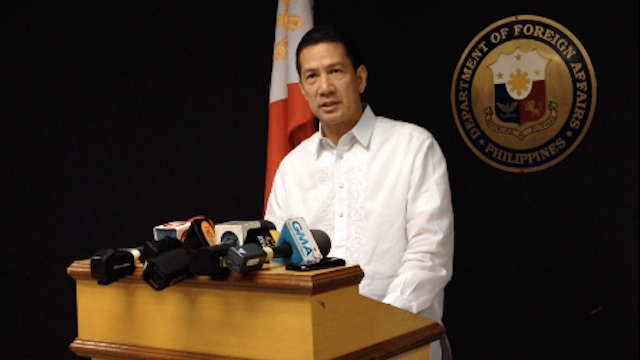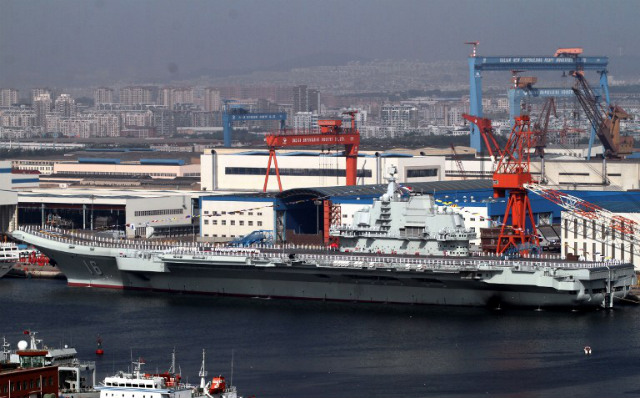BY RAPPLER.COM
POSTED ON 11/27/2013 6:05 PM | UPDATED 11/27/2013 7:16 PM
 BEHAVE. Foreign Affairs Spokesman Raul Hernandez issues a statement following China's deployment of its aircraft carrier to the South China Sea, some parts of which are disputed territories. File Photo by Carlos Santamaria
BEHAVE. Foreign Affairs Spokesman Raul Hernandez issues a statement following China's deployment of its aircraft carrier to the South China Sea, some parts of which are disputed territories. File Photo by Carlos SantamariaMANILA, Philippines – The Department of Foreign Affairs slammed China's move to send its aircraft carrier to the South China Sea.
In a press briefing on Wednesday, November 27, Foreign Affairs spokesman Raul Hernandez said that the aircraft carrier's deployment raises tension and violates the Declaration on the Conduct of Parties in the South China Sea (DOC) and warns that it must not violate international law – particularly that of the United Nations Convention on the Law of the Sea (UNCLOS).
Hernandez added that the deployment should only be for "peaceful purposes."
"Its deployment does not contribute to regional stability," Hernandez said. "Instead, [it] serves to threaten the status quo."
Chinese state news agency Xinhua reported on Tuesday, November 26, that Beijing's sole aircraft carrier departed for its first ever sea trials in the South China Sea.
The aircraft carrier was accompanied by two destroyers and two missile cruisers which make up a standard aircraft carrier battle group.
China's sole aircraft carrier is a a refurbished vessel purchased from Ukraine and named "Liaoning." It went into service in September 2012.
Such developments follow Beijing's recent establishment of an Air Defense Identification Zone (ADIZ) over the East China Sea, an area that contains disputed islands known as Diaoyu in Chinese and Senkaku to its Japanese claimants.
US, Japan say no
Beijing is requiring all international aircraft passing through the ADIZ to make themselves known to Chinese authorities and issue a flight plan – an order that Japan immediately rejected. (READ: Japan's Abe calls air defense zone dangerous)
On Tuesday, two US B-52 bombers flew over a disputed area of the East China Sea without informing Beijing, challenging China's bid to create an expanded air defense zone. (READ: US challenges China's air defense zone)
Australia also expressed concern on the matter and summoned the Chinese Ambassador to Australia for an explanation.
The White House, meanwhile, denounced China's move, calling it "unnecessarily inflammatory."
The US went on to provoke China's move to assert sovereignty over the disputed areas by letting two of their B-52 bombers fly over the zone.
The two bombers reportedly took off from the Anderson Air Force Base in Guam as part of an ongoing training program the US called Coral Lightning Global Power Training Sortie.
The US government said the exercise was planned way before China's establisment of the ADIZ.
Aside from the Daioyu/Senkaku dispute with Japan, China is engaged in territorial disputes with several other countries.
China claims virtually the whole of the South China Sea where the Spratlys, the Paracel Islands, and the Macclesfield Bank are located, earning the ire of the Philippines, Taiwan, Malaysia, Vietnam, and Brunei which claim some of the island territories and land features included in the three areas. – Rappler.co
In another article:
Aquino on China carrier: Not a threat
BY PATERNO ESMAQUEL II
POSTED ON 11/28/2013 3:01 PM | UPDATED 11/28/2013 5:10 PM
 THREATENING PH? China's first aircraft carrier, the 'Liaoning' sits berthed at the naval base in Dalian, northeast China's Liaoning province on Sept 25, 2012. File photo by AFP
THREATENING PH? China's first aircraft carrier, the 'Liaoning' sits berthed at the naval base in Dalian, northeast China's Liaoning province on Sept 25, 2012. File photo by AFPMANILA, Philippines – Echoing his softened tone toward China, President Benigno Aquino III on Thursday, November 28, downplayed the rising superpower's move to send an aircraft carrier to the disputed South China Sea.
“Let's not play it up,” Aquino told reporters, when asked if the aircraft carrier poses an “immediate threat” to the Philippines.
He said the Chinese, after all, admitted that the aircraft carrier is “not yet fully operational.” It will take up to 3 years for it to run in full steam, he said.
For the President, this means “they're learning carrier operations, both the crews onboard the planes and also the pilots who will be flying the planes. So they are transiting here.”
Aquino said, “Why should anybody consider it a threat?”
Escorted by missile destroyers and frigates, China's first aircraft carrier went on a training mission in the South China Sea last Tuesday, November 26.
The newly-commissioned Liaoning left its home port of Qingdao accompanied by two missile destroyers, the Shenyang and Shijiazhuang, and two missile frigates, the Yantai and Weifang, the official Xinhua news agency said.
The Philippines' Department of Foreign Affairs (DFA) on Wednesday, November 27, said the aircraft carrier's deployment “serves to threaten the status quo.” (READ: 'China threatening status quo' – DFA.)
'Infringes on air freedom'
The deployment came after China stirred tension over another body of water.
Over the weekend, China announced an Air Defense Identification Zone (ADIZ) in the East China Sea.
The air defense zone requires aircraft to provide their flight plan, declare their nationality and maintain two-way radio communication, or face “emergency defensive measures.”
The zone covers Tokyo-controlled islands – known as Senkaku in Japan and Diaoyu in China – where ships and aircraft from the two countries already shadow each other.
In a statement on Thursday, the DFA said the ADIZ "transforms the entire airzone into its domestic airspace, infringes on the freedom of flight in international airspace, and compromises the safety of civil aviation and national security of affected states."
"The Philippines calls China to ensure that its ADIZ preserves regional security and stability," the DFA added.
Threat to PH, too
In an interview on ABS-CBN, Philippine Foreign Secretary Albert del Rosario said the ADIZ also poses a threat to the Philippines. Del Rosario said he fears China "will control the air space" in the South China Sea.
China has been steadily increasing its military and coast guard presence in the South China Sea in recent years to assert its claim.
This caused diplomatic tensions to rise and stoking concerns in the Philippines about perceived Chinese bullying.
The Philippines filed a historic case against China over the dispute, while Aquino softened his tone.
In October, for instance, Aquino declined to explicitly tell China to back off from the disputed Panatag (Scarborough) Shoal, the site of a Manila-Beijing standoff in 2012, as well as the Ayungin (Second Thomas) Shoal.
The President said the international tribunal, in the end, will seal the fate of what he calls the “sea known by many names.” (READ: Aquino won't tell China to leave Panatag.)
He said his country, too, is helping craft a Code of Conduct (COC) on the South China Sea, a binding document to ensure peace in the disputed sea.
“The bottom line is, we are undergoing arbitration. We are pursuing the second track with the COC. And at the end of the day, either or both will seek to clarify everybody's entitlements with regard to this body of water,” Aquino said. – with reports from Agence France-Presse/Rappler.com

No comments:
Post a Comment